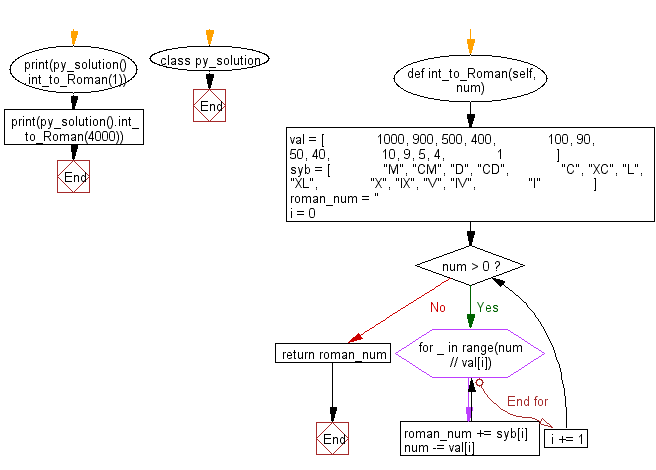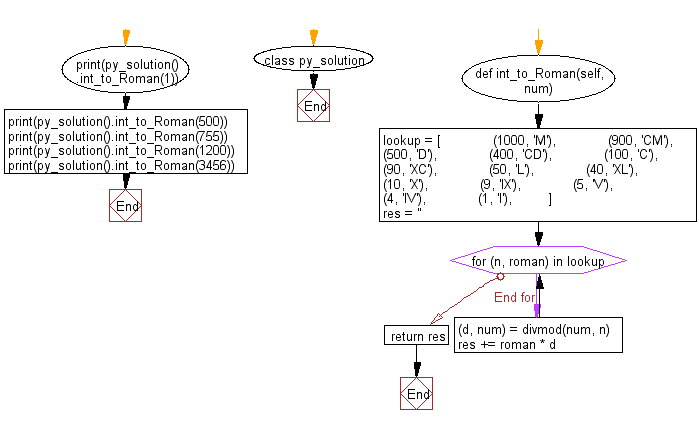Python: Convert an integer to a roman numeral
1. Convert an Integer to a Roman Numeral
Write a Python class to convert an integer to a Roman numeral.
Sample Solution-1:
Python Code:
class py_solution:
def int_to_Roman(self, num):
val = [
1000, 900, 500, 400,
100, 90, 50, 40,
10, 9, 5, 4,
1
]
syb = [
"M", "CM", "D", "CD",
"C", "XC", "L", "XL",
"X", "IX", "V", "IV",
"I"
]
roman_num = ''
i = 0
while num > 0:
for _ in range(num // val[i]):
roman_num += syb[i]
num -= val[i]
i += 1
return roman_num
print(py_solution().int_to_Roman(1))
print(py_solution().int_to_Roman(4000))
Sample Output:
I MMMM
Pictorial Presentation:
Flowchart:

Sample Solution-2:
Convert an integer to its roman numeral representation. Accepts value between 1 and 3999 (both inclusive).
- Create a lookup list containing tuples in the form of (roman value, integer).
- Use a for loop to iterate over the values in lookup.
- Use divmod() to update num with the remainder, adding the roman numeral representation to the result.
Python Code:
class py_solution:
def int_to_Roman(self, num):
lookup = [
(1000, 'M'),
(900, 'CM'),
(500, 'D'),
(400, 'CD'),
(100, 'C'),
(90, 'XC'),
(50, 'L'),
(40, 'XL'),
(10, 'X'),
(9, 'IX'),
(5, 'V'),
(4, 'IV'),
(1, 'I'),
]
res = ''
for (n, roman) in lookup:
(d, num) = divmod(num, n)
res += roman * d
return res
print(py_solution().int_to_Roman(1))
print(py_solution().int_to_Roman(500))
print(py_solution().int_to_Roman(755))
print(py_solution().int_to_Roman(1200))
print(py_solution().int_to_Roman(3456))
Sample Output:
I D DCCLV MCC MMMCDLVI
Flowchart:

For more Practice: Solve these Related Problems:
- Write a Python class that uses a dictionary mapping of numeral values and an iterative approach to convert a given integer to its Roman numeral representation.
- Write a Python class that implements a recursive algorithm to convert an integer to a Roman numeral, handling both small and large numbers.
- Write a Python class that validates input and raises exceptions for integers outside the accepted range for Roman numeral conversion.
- Write a Python class that takes a list of integers and returns a list of their Roman numeral representations using a class method.
Go to:
Previous: Python Class exercises.
Next: Write a Python class to convert a roman numeral to an integer.
Python Code Editor:
Contribute your code and comments through Disqus.
What is the difficulty level of this exercise?
Test your Programming skills with w3resource's quiz.
